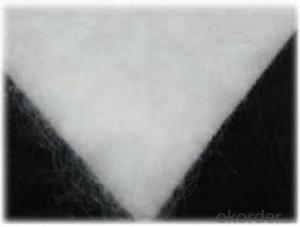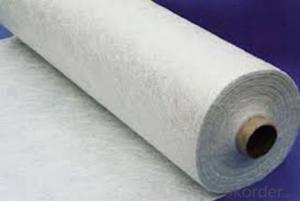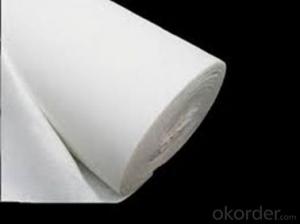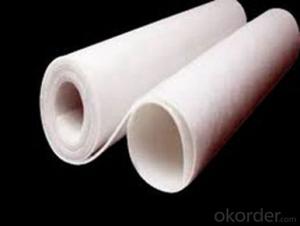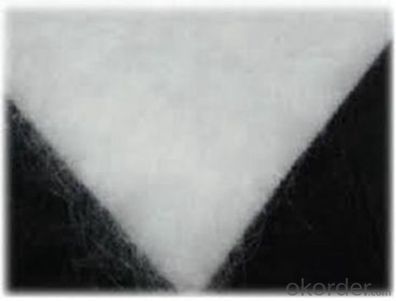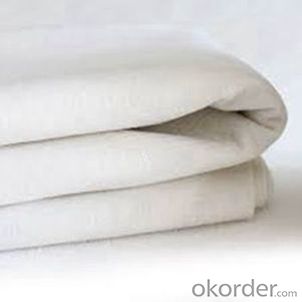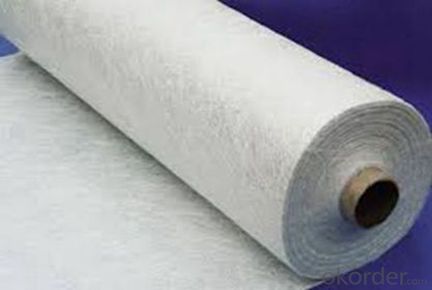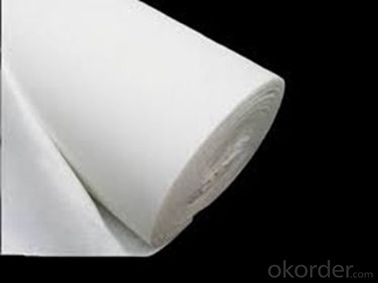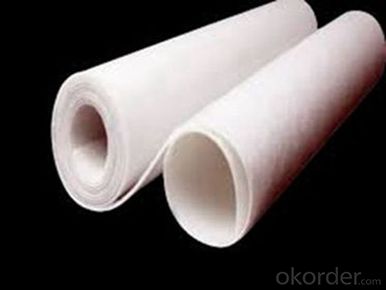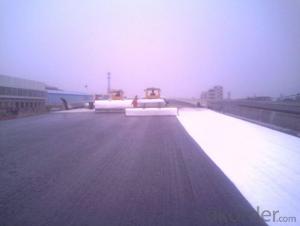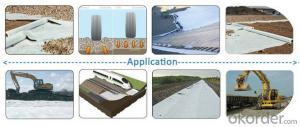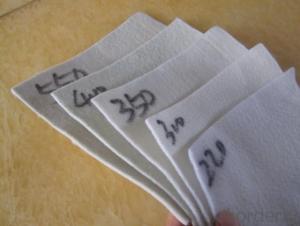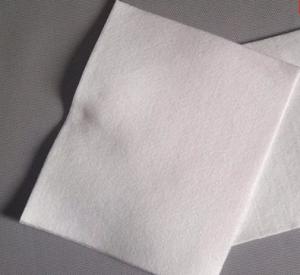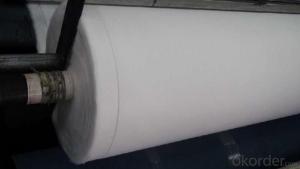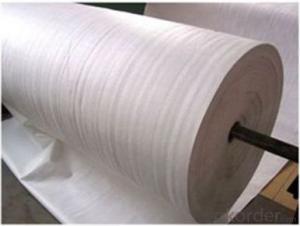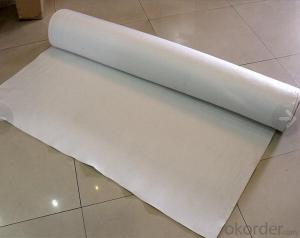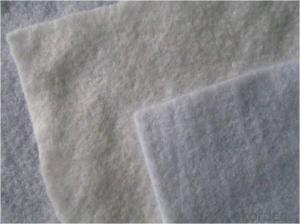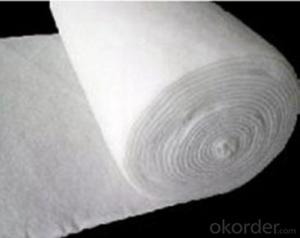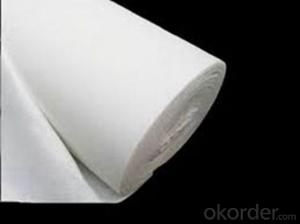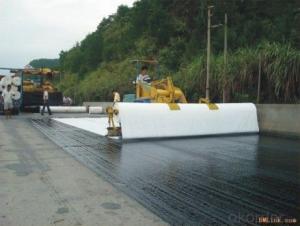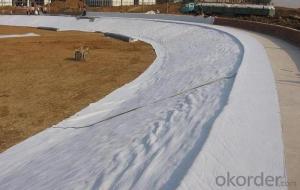PP Nonwoven Geotextile Fabrics - Geotextil Colombia - CNBM from China
- Loading Port:
- China main port
- Payment Terms:
- TT OR LC
- Min Order Qty:
- 4000 g/m²
- Supply Capability:
- 1000000 g/m²/month
OKorder Service Pledge
OKorder Financial Service
You Might Also Like
Specification
Description:
Nonwoven Geotextile 600G/M2 Geotextile Pp Non-Woven Geotextile Bags Made In China is a special kind of nonwoven geotextile because of its special manufacture method by puncturing the rolling formed layer made of randomly oriented short staple fiber. Our raw material is the top class 100% new PP(Polyproplylene) or PET(Polyester) fiber. The needle punch process involves forcibly entangling layers of loose staple fibre into three dimensional structure by sequentially punching and pulling out barbed needles through the fiber matrix, and forms a strong fabric that retains its dimensional stability, expands the serving year to all the applied project. Because of its proven track record and versatility, Needle Punched, as the most commonly used Nonwoven Geotextile, is widely used in civil and environmental engineering applications like subsurface drainage, roadway separation, railroad stabilization, erosion control, hard armor underlayment, landfill leachate collection, underground retention/detention systems, environmental protection and other projects.
Specification:
Mass Per Unit Area: 100-900g/m2
Fiber Type: Staple fiber
Color: White, Black, Grey
Width Range: 1-6m
Length: 50m/100m/120m
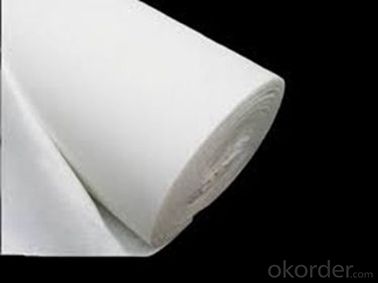
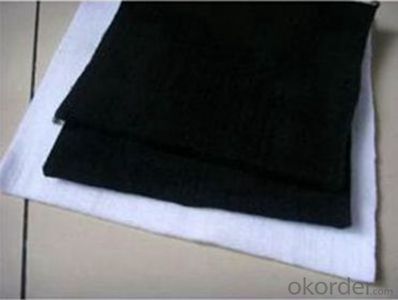
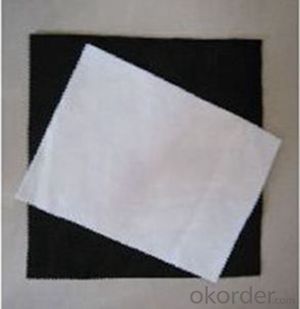
Quality assurance
1.On a regular basis or as per your request,we entrust national testing agencies to conduct quality inspections
2. Strictly in accordance with the ISO9001-2008 international quality system standard,we monitor and manage the whole process throughout production,quality testing,and measurement to ensure product quality
3. For quality-related construction delay or substandard construction(except for damage or losses due to customer’s responsibility or irresistible natural disasters),we have refunding,replacement,and repair services.We will respond to customers’ feedbacks on quality issues within 24 hours.
After-sales service
1.In order to provide customers with comprehensive technical support,we will provide technical and other related information upon request in a timely manner.
2.In required,we will appoint specialized technicians to the construction site to give technical trainings to construction people,and offer technical guidance throughout the whole construction process.
3.For damage due to shipment and delivery,after we receive the complaint,we will check the issure through provided pictures and videos.If our responsibility is confirmed,we wil offer free replacement.
4.When the construction is completed,as your request,our technical staff may participate in the final acceptance.
FAQ:
Q: What kind of payments does jenor support?
A: T/T, L/C, Cash are accepted.
Q: Do you charge for the samples?
A: Accordeing to our company policy, the samples are free, we only charge the freight fee. And we will return the freight fee during the next order.
Q: Can you produce according to customers' design?
A: Sure, we are professional manufacturer, OEM and ODM are both welcome.
Q: Do you have other products?
A: Yes, please check the pictures:
- Q: Can geotextiles be used in geogrid reinforcement applications?
- Yes, geotextiles can be used in geogrid reinforcement applications. Geotextiles are often used in conjunction with geogrids to provide additional support and stabilization to the soil. The geotextile acts as a separation layer, preventing the intermixing of different soil layers and enhancing the overall performance of the geogrid reinforcement system.
- Q: What are the different geotextile installation techniques for roadways?
- There are several geotextile installation techniques for roadways, including overlay installation, trench installation, and full-depth installation. Overlay installation involves placing the geotextile on top of the existing road surface before applying a new layer of asphalt or other material. Trench installation involves placing the geotextile in a trench dug along the road's edge and backfilling it with soil or aggregate. Full-depth installation involves placing the geotextile directly beneath the entire road structure, providing reinforcement and separation between the subgrade and the overlying layers. The choice of technique depends on the specific road construction requirements and the desired benefits of using geotextiles.
- Q: Woven geotextile is not considered a spinning geotextile
- Woven geotextile is made of textile technology is a spinning geotextile.
- Q: Can geotextiles be used in the construction of golf course bunkers?
- Yes, geotextiles can be used in the construction of golf course bunkers. Geotextiles are often used as a lining material in bunkers to prevent contamination of the sand from the underlying soil and to enhance the performance and longevity of the bunker. They can help with erosion control, drainage, and stability of the bunker, ultimately improving the overall playing experience on the golf course.
- Q: How do geotextiles contribute to the longevity of geosynthetic clay liners?
- Geotextiles contribute to the longevity of geosynthetic clay liners by providing additional protection and reinforcement. They act as a barrier, preventing the intrusion of fine particles into the clay liner, which can cause clogging and reduce its effectiveness. Geotextiles also help distribute loads evenly, reducing stress on the clay liner and preventing its deformation or failure. Additionally, they enhance the drainage properties of the liner by facilitating the flow of water, reducing the risk of pore pressure build-up. Overall, geotextiles play a crucial role in enhancing the durability and lifespan of geosynthetic clay liners.
- Q: Can geotextiles be used in flood protection projects?
- Yes, geotextiles can be used in flood protection projects. Geotextiles are often used as a cost-effective and sustainable solution for erosion control, sediment filtration, and stabilization of soil in flood-prone areas. They can be used in various applications such as riverbank protection, levee reinforcement, and shoreline stabilization, helping to reduce the impact of floodwaters and prevent soil erosion.
- Q: Are geotextiles suitable for use in groundwater remediation systems?
- Yes, geotextiles are suitable for use in groundwater remediation systems. Geotextiles can serve as effective filters and barriers, preventing the migration of contaminants while allowing for the flow of water. They can be used to line trenches and basins, as well as to create permeable reactive barriers, enhancing the efficiency of remediation efforts by controlling and directing groundwater flow. Additionally, geotextiles are durable and resistant to chemical degradation, making them well-suited for long-term use in groundwater remediation systems.
- Q: What are the different factors affecting the durability of geotextiles?
- The different factors affecting the durability of geotextiles include the quality of materials used, the manufacturing process, the environmental conditions in which they are installed, and the level of stress and strain they are subjected to.
- Q: Are geotextiles resistant to creep deformation?
- Yes, geotextiles are generally resistant to creep deformation. They are designed to have stable and long-term performance under sustained loads, minimizing the potential for creep.
- Q: Whether the reservoir is geotextile or geomembrane is good
- Composite geomembrane and geomembrane can be. Detailed consultation to see the information
Send your message to us
PP Nonwoven Geotextile Fabrics - Geotextil Colombia - CNBM from China
- Loading Port:
- China main port
- Payment Terms:
- TT OR LC
- Min Order Qty:
- 4000 g/m²
- Supply Capability:
- 1000000 g/m²/month
OKorder Service Pledge
OKorder Financial Service
Similar products
Hot products
Hot Searches
Related keywords
